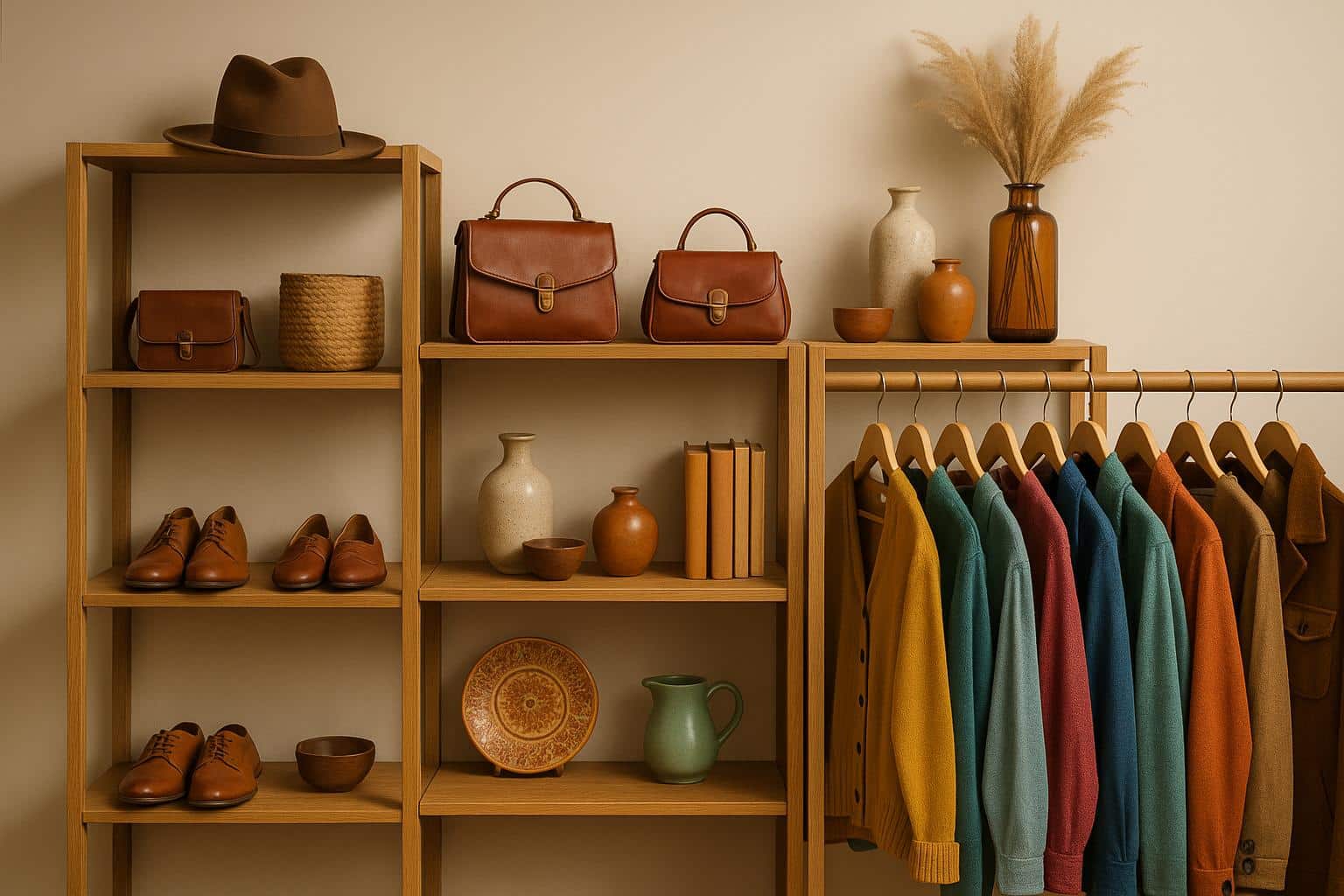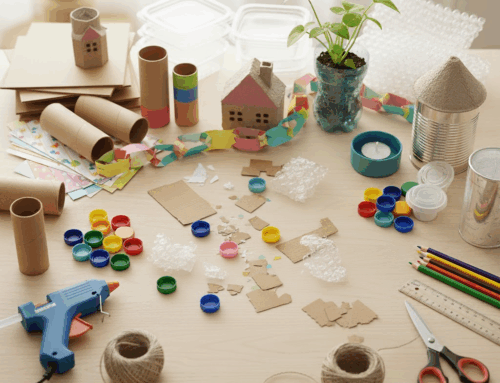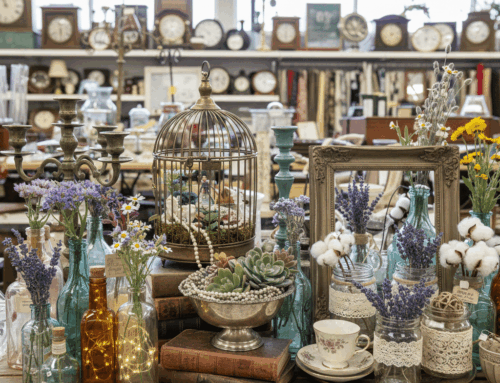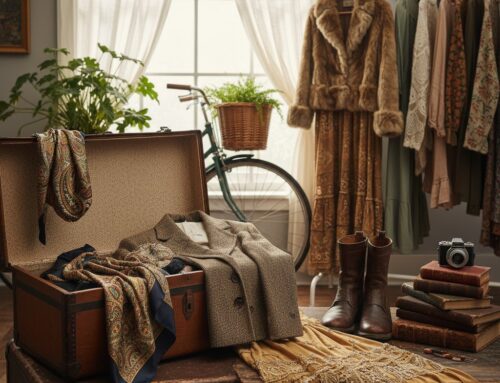Want to boost thrift store sales? Start with better displays.
Research shows that 70% of buying decisions happen in-store, and 62% of shoppers make impulse purchases when drawn to eye-catching layouts. Organized, strategic displays can even increase sales by up to 540%. Here’s a quick rundown of how to showcase popular items effectively:
- Prime Placement: Position high-demand items where customers naturally look first – entrance areas, main aisles, and eye-level shelves (47–62 inches from the ground).
- Story-Based Grouping: Arrange items into themes or setups (e.g., a cozy reading nook or a complete outfit) to inspire purchases.
- Color Coordination: Group items by color to create visually appealing displays that help shoppers find what they want.
- Regular Updates: Refresh displays every 2–6 weeks to avoid “display fatigue” and keep customers engaged.
- Interactive Areas: Allow customers to test electronics, flip through books, or try games to boost confidence in their purchase decisions.
- Lighting Matters: Use focused lighting to highlight key items and enhance their appeal.
- Smart Pricing: Use strategies like price anchoring, charm pricing ($9.99 vs. $10), and tiered pricing to guide buying decisions.
- Community Input: Involve customers, volunteers, and staff in choosing featured items to create displays that resonate locally.
These tips don’t just improve sales – they create a better shopping experience, encourage repeat visits, and support your store’s mission. Start implementing these strategies today to make your thrift store stand out.
1. Place Items Where Customers See Them First
When customers step into your store, you have just a few seconds to grab their attention. How you position your key products can make all the difference.
Research indicates that 90% of shoppers naturally turn right when entering a store. This makes the entrance area incredibly valuable for showcasing your most in-demand items. The first 5 to 15 feet of your store set the tone for your entire brand and value. Avoid wasting this prime space on clearance or outdated stock.
Another key insight: the ideal spot to catch a shopper’s eye is about 14.7 inches below eye level, which translates to 47–62 inches from the ground for the average adult. This range aligns with a person’s natural line of sight, making it perfect for displaying your best merchandise without requiring customers to strain or bend.
Your store’s main aisles act like highways, ensuring maximum visibility. Use these areas to display your high-margin or best-selling products at eye level, while reserving lower shelves for less critical items. Similarly, endcap displays – those at the end of aisles – are excellent for promoting seasonal items, new arrivals, or complementary products.
To draw attention to high-traffic zones, use bold colors, unique textures, or focused lighting. These visual cues naturally guide shoppers toward featured products.
At checkout, position smaller, enticing items like jewelry or accessories. Studies show that 27% of shoppers make impulse purchases at the register, which can significantly increase your average sale value.
“The secret to effective product placement in stores lies in creating a seamless journey for customers – one where they discover products they need and want, even if they didn’t know it when they walked in.” – Anna Brown, Retail Store Manager
Finally, use customer traffic data to refine your product placements over time. This ensures your layout stays effective and keeps up with changing shopping behaviors.
2. Create Story-Based Item Groups
Shoppers are drawn to items that feel like they belong in their lives. Story-based displays make this connection easier by showing how different pieces can work together, creating an emotional pull that turns browsing into a more engaging experience.
The idea is simple: group related items to tell a story. Instead of scattering a vintage blazer, handbag, and pumps across the store, bring them together on a mannequin or a dedicated display. This lets customers see a complete look and imagine themselves wearing it, whether for work or a special occasion.
“Use your products to set a scene and tell a story.” – Retail Control Systems
This strategy works especially well with furniture. For example, set up a cozy reading nook with a vintage armchair, a side table, a lamp, and a stack of books. Or create a dining setup with a table, chairs, place settings, and decorative touches. When people can picture these setups in their own homes, they’re more likely to consider buying multiple items. You can also take this further by creating era-themed displays that bring a specific mood or period to life.
Era-themed sections add an extra layer of charm by transporting shoppers to another time. Picture a mid-century modern living room with sleek furniture and atomic-age accents, or a “Clueless”-inspired corner filled with ’90s fashion and decor. Stores like City Thrift use this method to connect with their community, inviting shoppers to rediscover hidden gems in a fun, nostalgic way.
Storytelling in retail isn’t just about selling products – it’s about creating an experience. By presenting a lifestyle or vibe that customers can see themselves in, you encourage them to explore and take home a cohesive collection of items. Cross-merchandising helps here, too. Placing complementary items together – like jewelry near clothing, throw pillows by sofas, or mason jars in a rustic kitchen display – can inspire customers to pick up pieces they didn’t even know they wanted.
3. Group Items by Color for Visual Impact
Arranging items by color isn’t just about tidying up – it’s a way to create eye-catching displays that make shopping easier and more enjoyable. This technique blends style with practicality, helping customers quickly find what they’re looking for while making your store visually appealing.
Here’s something interesting: 90% of customers base their product decisions on color alone, and 85% say color is a key factor in their purchases. These numbers show how powerful color can be when it comes to influencing buying behavior.
One effective approach is color blocking. For example, place a brightly colored product against a neutral background to make it stand out, or group items with similar shades to create a harmonious arrangement. According to Michelle Sherrier, this method not only makes shopping simpler but also creates a welcoming vibe.
Color coding isn’t just for looks – it’s also practical. It creates a logical system that saves both customers and staff from rummaging through disorganized shelves. Think about clothing racks organized by color families: all blues together, followed by greens, reds, and so on. Similarly, home goods can be displayed by tone, with turquoise, coral, and sunny yellow items grouped to add energy and warmth to the space.
For a more polished look, try a monochromatic theme in specific sections. This works especially well for seasonal or themed displays, giving them a sleek and cohesive feel. Stores like City Thrift in Kansas City have mastered these techniques, using color coordination to design inviting, easy-to-navigate spaces that keep customers browsing longer and uncovering hidden gems they might have missed otherwise.
4. Change Displays on a Regular Schedule
Switching up your displays regularly keeps customers coming back for more. When displays stay the same for too long, they tend to blend into the background – a phenomenon known as “display fatigue.” And here’s the kicker: over 68% of purchasing decisions happen right in the store, and about 52% of shoppers return because of eye-catching displays.
To keep things fresh, try minor updates every two to six weeks. This could mean swapping out key items or rearranging sections. For bigger changes, like seasonal or holiday updates, aim for monthly refreshes. If you’ve just received new inventory, let the current layout sit for about two weeks before shaking things up. This gives customers time to fully appreciate the original setup.
Updating displays isn’t just about aesthetics; it can also enhance how people perceive your brand. Nearly 73% of customers associate a brand’s quality with its physical space. And when customers feel emotionally connected to your store, they’re worth up to 306% more over their lifetime. A great example of this is City Thrift in Kansas City, where frequent display updates ensure every visit feels like a treasure hunt.
Simple tweaks can go a long way. Move older displays to more visible areas, swap out background graphics, or quickly replace items that sell out. During busy times like the holidays, consider updating your featured displays weekly – or even daily – to keep up with the surge in shoppers.
5. Set Up Hands-On Display Areas
Letting shoppers interact with products can make a huge difference in their buying decisions. Whether it’s testing electronics, flipping through books, or handling toys and games, hands-on displays give customers the confidence they need to make a purchase. Here’s how to make the most of these areas.
For electronics, create a dedicated space where customers can try out devices. Make sure the area has enough outlets and is positioned near the electronics display but away from crowded walkways to keep things organized. If the items are pre-tested, highlight that with a sign and a guarantee – it builds trust and reassures buyers.
When it comes to books, arrange them in a way that makes browsing easy. Sorting by author or genre allows customers to quickly find what they’re interested in while encouraging them to explore other options.
For games and toys, a demo table can work wonders. Families will appreciate being able to inspect board games or see how toys operate. Setting up a partially completed puzzle is another great way to showcase quality and condition while sparking interest.
To keep these areas inviting, stick to a regular cleaning schedule. Make sure electronics are functional, books stay neat, and all game pieces are accounted for. A clean and well-maintained display not only looks professional but also prevents customer frustration.
Finally, ensure your displays are accessible to everyone. Use appropriately sized tables, provide plenty of lighting, and keep pathways clear for wheelchairs and strollers. This thoughtful design makes shopping enjoyable for all.
6. Use Better Lighting on Key Items
Lighting can make or break a product’s appeal. Studies reveal that effective lighting can increase retail sales by as much as 40%. For instance, an ENERGY STAR study showed that U.S. grocers who switched to LED lighting saw a 19% boost in sales. Integrated lighting solutions have also been shown to double item selection while driving 44% higher dollar sales and 37% higher unit sales.
But lighting does more than just improve sales – it also impacts how customers feel while shopping.
“Lighting has a direct influence on our mood, with 80% of the sensory information the brain receives coming from our eyes. Lighting highlights architectural elements, product qualities and creates virtual spaces – impacting how we feel, what we think of a product, and ultimately the choice of whether to purchase or not.”
– Mihaly Bartha, Head of Lighting at GPStudio
To make the most of your lighting, focus on highlighting key items. For example, track lighting can be used to create focal points above high-value displays like designer clothing, vintage collectibles, or electronics. Adjustable track lights allow you to easily direct attention to specific products.
For textiles and clothing, directional spotlights are ideal. They bring out the texture and craftsmanship of items like vintage pieces or brand-name apparel, helping customers appreciate the fine details without harsh shadows.
Another smart option is LED strip lighting. Installing LED strips under display racks can elevate the look of your merchandise. A 16-foot LED strip with 3 watts costs about $12, and you’ll need an $18 transformer to power it. This small investment can make a big difference in how your items are perceived.
Varying light intensity is another effective strategy. Use brighter, high-intensity lighting to draw attention to sale or featured items, while softer lighting creates a relaxed atmosphere in browsing areas. Adjustable fixtures allow you to adapt to changing displays, keeping your store dynamic and visually appealing.
Finally, be mindful of glare and color distortion. Position lights carefully to ensure they illuminate products without blinding customers or altering the way colors appear. Concealing light sources from direct view helps create a welcoming environment where shoppers can examine items comfortably.
7. Use Smart Pricing to Guide Purchases
Smart pricing is a clever way to influence how customers perceive value and make decisions. It builds on dynamic displays by using pricing strategies to nudge shoppers toward specific choices.
One effective tactic is price anchoring. When you place a high-priced item next to a lower-priced one, it sets a reference point for value. For example, a $50 jacket displayed alongside a $30 one makes the latter seem like a better deal, even if the $30 jacket was already a fair price.
Another strategy is the decoy effect, which involves adding a third, less appealing option to steer customers toward your target product. Picture this: three winter coats displayed together – a premium wool coat for $35, a cotton blend for $32, and a high-quality down jacket also priced at $35. The cotton blend becomes the “decoy”, making the down jacket seem like the obvious choice for better value.
Tiered pricing displays are also highly effective. Group products into categories like “Good”, “Better”, and “Best”, with ascending price points. For instance, you might label jackets as “Good” for $8, “Better” for $12, and “Best” for $18. A vintage leather jacket marked as “Best” at $25, displayed alongside the “Good” and “Better” options, highlights its superior quality and helps customers feel confident in their decision.
Then there’s charm pricing, where prices end in 9 – for example, $9.99 instead of $10. This simple tweak can increase sales by up to 24% because it subtly signals a bargain to customers.
When displaying items for price comparison, think beyond just the numbers. Group similar products by category or quality to tell a story. For instance, placing a $28 vintage designer handbag next to a $12 contemporary bag highlights the quality difference, helping shoppers justify their choice based on their priorities – whether it’s style, budget, or uniqueness.
At City Thrift, these smart pricing techniques are seamlessly integrated into curated displays, giving customers a clear sense of value while encouraging them to explore and discover great deals. Smart pricing and visual merchandising work together to create a shopping experience that feels both intuitive and rewarding.
8. Let Community Members Help Choose Featured Items
Your community knows what it wants. By involving customers, volunteers, and staff in deciding which items get featured in your displays, you can create a shopping experience that feels personal and relevant. This approach not only improves your store’s merchandising but also strengthens your connection with the local community.
The benefits of community involvement go beyond just better displays. Engaged customers are a game-changer – they generate 23% more revenue than average shoppers and are 50% more likely to recommend your store to others. When people feel their opinions matter, they’re more likely to support your store and spread the word about it. This initial engagement also opens the door for more meaningful feedback in the future.
Start by gathering input in simple, everyday ways. Ask customers for their opinions while they browse or check out. A quick question like, “What kinds of items would you like to see featured more often?” can reveal surprising insights. Maybe your community loves vintage band t-shirts, retro kitchen gadgets, or warm kids’ coats for back-to-school season. To dive deeper, use short surveys – just three to five questions – with prompts like, “Which product categories should we highlight?” or “What items deserve a spot in our displays?”
Don’t overlook your staff and volunteers – they’re on the front lines and often know what excites customers the most. Organize team meetings where they can share suggestions based on customer interactions or point out items that consistently sell well.
Take the conversation online, too. Social media is a powerful tool for engaging your audience. Post photos of potential featured items and ask followers to vote for their favorites. Polls are another great way to find out what people want to see in your store.
You can also take it a step further by hosting community events. Invite customers to browse new inventory and share their thoughts on what should be featured. These events not only help you gather feedback but also strengthen relationships and make your store feel like a hub for the community.
Craig Pedersen from Hope Gospel Mission highlights the importance of this social connection:
“Thrift shopping thrives on social interaction. Customers shop not just for products but for the experience and community connection…. We see more customers come just because they like the social aspects of interacting with our staff and each other and finding that deal. Just enjoying that whole experience more so than just needing more product.”
By weaving community input into your merchandising strategy, you create displays that truly resonate. At City Thrift, for example, listening to local shoppers has helped them design displays that appeal to Kansas City residents while supporting their mission to assist those facing homelessness and poverty. When your community helps shape what’s featured, they feel like active participants in your store’s success.
To keep improving, track sales data and gather feedback on community-suggested displays. This not only validates the importance of customer input but also creates a cycle of continuous growth that benefits everyone involved.
Conclusion
The eight strategies outlined here are proven to draw in customers and drive sales. For example, well-crafted displays can increase sales by as much as 540% and influence 84% of consumer decisions. Simple tactics like positioning popular items strategically, using storytelling in product groupings, and coordinating colors can make a big difference. Adding a community-focused approach further enhances the customer experience and encourages repeat visits.
Tim Gebauer, an expert in thrift, e-commerce, and retail, sums it up perfectly:
“Good merchandising, no matter the style of store, adds value in the form of convenience for the customer.”
This “convenience” not only simplifies the shopping process but also helps customers discover more products. The best part? You don’t need to invest in expensive equipment or major renovations. Adjusting product placement, selecting items thoughtfully, and creating seasonal displays can deliver noticeable results. Most of these changes can be implemented right away using your current inventory and some basic lighting tweaks.
These strategies do more than just improve sales – they also align with City Thrift’s mission. By enhancing merchandising, stores like City Thrift can increase revenue and make the most of every donated item. This ensures that more funds support City Union Mission’s programs, which assist individuals facing homelessness and poverty in Kansas City. Positive shopping experiences encourage customers to return, donate quality items, and spread the word, creating a cycle of benefits for the entire community.
Keeping displays updated with seasonal themes and fresh ideas is essential for maintaining customer interest. Regular updates and community input ensure that the store stays dynamic and focused on its mission. When done right, visual merchandising not only enhances the shopping experience but also inspires repeat visits and purchases.
Stop by City Thrift to see these techniques in action and become part of a community committed to meaningful change.
FAQs
How can I identify high-demand items in my thrift store and showcase them effectively?
To figure out which items are flying off the shelves at your thrift store, start by paying attention to what’s trending. Things like vintage clothing, well-known designer brands, and one-of-a-kind home decor pieces often catch shoppers’ eyes. Dive into your sales data regularly – this can reveal which items or categories are selling fast, giving you a clear picture of what’s in demand.
Once you’ve nailed down those high-demand items, make sure they’re front and center. Placing them near the entrance or in standout displays can grab attention and entice customers to browse. Keep your displays fresh by updating them based on trends and what’s selling well. This keeps your store exciting and encourages repeat visits. Staying on top of these strategies can keep your store buzzing with activity and sales rolling in.
How can I involve the community in choosing featured items for my thrift store?
Engaging your local community in choosing featured items for your thrift store is a smart way to better understand customer preferences while building a stronger connection with your audience. One effective approach is partnering with local nonprofits, schools, or community groups to host events like donation drives or volunteer days. These gatherings not only strengthen relationships but also offer valuable insights into what items people are actively seeking.
Another way to gather input is by using simple tools, like in-store suggestion boxes or online surveys. Social media also provides a fantastic platform for interaction – ask your followers about their favorite finds or what they’d love to see more of. These efforts make your store feel more connected to the community, creating a sense of inclusivity and encouraging loyalty among customers.
How often should I refresh my thrift store displays to keep customers engaged?
Keeping your thrift store displays fresh and appealing is key to maintaining customer interest. Aim to update your displays at least once a month. During busier times, like the holiday season, consider refreshing them more often – weekly or even daily – to showcase seasonal items and keep things lively.
Regular updates do more than just fight off display fatigue; they also give customers a reason to come back, eager to see what’s new. A well-thought-out, updated display can boost sales and leave a lasting impression on shoppers.





